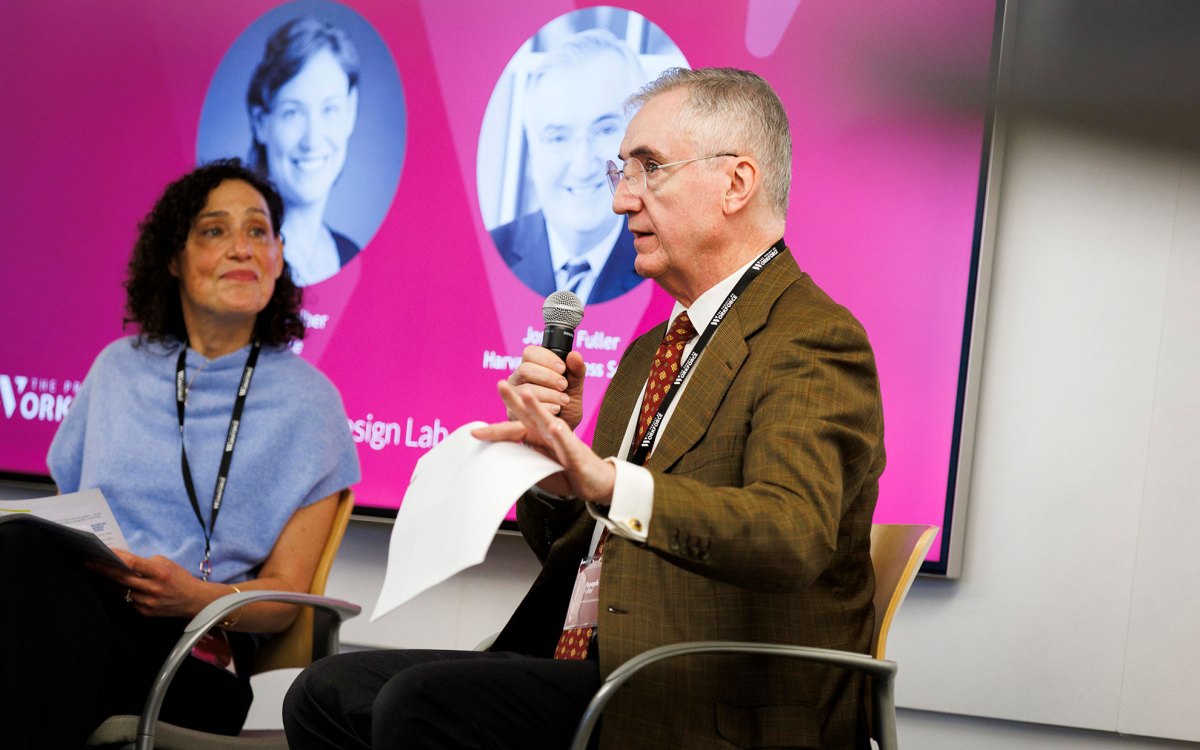Death penalty, in retreat
Fewer states impose the sentence, and U.S. rulings narrow it, professor says
Carol Steiker’s interest in criminal justice took hold while she was at Harvard Law School (HLS) in the 1980s. While studying there, she recalled, “It began to appear to me that criminal justice was a great engine of American inequality.” Steiker became interested in capital punishment while clerking for U.S. Supreme Court Justice Thurgood Marshall, an ardent opponent of the death penalty. Now the Henry J. Friendly Professor of Law at HLS, Steiker is using her year as the Radcliffe Institute for Advanced Study’s Rita E. Hauser Fellow to work with her brother and frequent collaborator, Jordan M. Steiker, on a book about the past half-century’s experiment with the constitutional regulation of capital punishment in America. She spoke with the Gazette about the history and future of the death penalty in the United States.
GAZETTE: Could you see the Supreme Court striking down the death penalty?
STEIKER: Yes, it would not surprise me if the death penalty were constitutionally invalidated sometime in the next couple of decades. The Supreme Court has been on a trajectory of narrowing and questioning the death penalty. In 2002, it held that people with mental retardation, now called intellectual disability, couldn’t get the death penalty. In 2005, it held that juvenile offenders couldn’t get the death penalty. In 2008, it held that people who commit crimes other than murder — even the crime of aggravated rape of a child — couldn’t get the death penalty. These are really significant limitations on capital punishment.
The court continues to express interest in key death-penalty issues. In January, the court granted certiorari [agreeing to hear a lower-court case] on questions regarding Oklahoma’s lethal-injection protocol, after botched executions in that state and elsewhere last year. It will decide this case by June and offer some more guidance on death by lethal injection in an era when states are finding it increasingly difficult to obtain appropriate drugs, given the unwillingness of many manufacturers to supply them for the purpose of executions. Other challenges to lethal-injection procedures continue to percolate at the state level, such as challenges to the transparency of the execution process — challenges to laws that hide the source of the drugs used or the identities of participants in the execution process.
GAZETTE: Why did the Supreme Court initially strike down the death penalty in 1972?
STEIKER: Prior to the landmark case of Furman v. Georgia in 1972, juries had regularly been told that they should look only to their conscience in deciding whether to impose the death penalty. Lawyers argued that it was unconstitutional to give this important power to jurors with no attempt to guide their discretion, because that would lead to randomness and to discrimination, a constitutionally intolerable result.
So the Supreme Court struck down the death penalty as it was then practiced across the country. But there was a huge backlash to Furman. Over the next few years, 35 states redrafted their capital statutes to offer what the Supreme Court later called “guided discretion.” As people began to pile up on death row in these states, the Supreme Court, knowing it had to rule on the constitutionality of this new generation of capital statutes, granted cert [certiorari] on five death-penalty cases from Georgia, Florida, Texas, North Carolina, and Louisiana. Ultimately, the Supreme Court upheld three of the new statutes that provided “guided discretion,” and struck down two that provided no discretion at all, that is, rejecting statutes that made the death penalty mandatory upon conviction of certain crimes.
On the basis of this new approach, the American death penalty was back in business. More and more people were sentenced to death, and more and more people were executed pretty much every year until the turn of the century. The death penalty reached a modern post-1976 high in 1999. In that year, 98 people were executed and nearly 300 were sentenced to death. Since 2000, however, the death penalty has been in sharp decline; you might even say free-fall. Executions are down by more than half, death sentences are down by more than two-thirds, and six states have legislatively abolished the death penalty in the past seven years. A federal judge declared California’s death penalty unconstitutional this past summer. We are living through a sea change on this issue.
GAZETTE: Can you tell me more about the history of capital punishment in America?
STEIKER: For most of American history, the death penalty was understood to be the creature of state and local law. From the colonial era until recent times, it was not a national issue. The authorization of capital punishment was on the colonial or state level, but the actual use of it was very much on the local level. As an example, in 1660 a Quaker woman named Mary Dyer was executed in Boston for heresy for being a Quaker in a Puritan colony. This is a great example of how the death penalty, starting in colonial times but continuing throughout American history, has been the expression of colonial, or state, and even local priorities. In the Massachusetts Bay Colony, things like heresy, adultery, sodomy, and witchcraft were really, really important, and those kinds of things were written into the capital code and produced a substantial number of executions.
Contrast that to, say, Southern colonies. If you look in Virginia, South Carolina, Georgia, and Louisiana (which was mostly under French control), capital statutes tended to focus on crimes by slaves, especially slave revolt, and you see a substantial number of executions for such offenses. These are good examples of how, throughout American history, the death penalty was authorized by states but used by local officials to enforce local priorities and to be a really dramatic statement of local concerns and values. Capital punishment really wasn’t thought to be an issue of overarching national regulation.
GAZETTE: What was the Supreme Court’s earliest involvement with the death penalty?
STEIKER: The Supreme Court was asked a number of times to weigh in on questions about capital punishment. In the late 19th century, the court was asked to declare the firing squad cruel and unusual, but the court declined. Then, in the middle of the 20th century, when the electric chair malfunctioned, the court was asked, “Could someone be executed a second time?” That was the famous Willie Francis case, argued in the Supreme Court by the judge I clerked for, Skelly Wright, early in his legal career. The Supreme Court said: “No, that’s fine.” Louisiana could put Willie Francis back in the electric chair and do it again (and it did).
The first time that the Supreme Court made constitutional law specific to the death penalty was kind of a preview of how the Supreme Court would eventually make the death penalty a subject of intensive constitutional regulation. That was in a case called Powell v. Alabama, also known as the Scottsboro Boys case. It involved nine black men who were accused in 1931 on very flimsy evidence of raping two white women. Now it is recognized that they were not guilty. But at the time, they were tried over the course of just a few days and found guilty and sentenced to death in incredibly cursory proceedings. They had essentially no legal representation. Two lawyers were present in the courtroom, but they but had been appointed only days before, were unfamiliar with state law, and had done no preparation. The Supreme Court held in that case that in capital cases you had a federal constitutional right to be represented by counsel, a right that it would eventually extend to criminal defendants in non-capital cases — but not for another 30 years.
But after Scottsboro in the 1930s, the Supreme Court didn’t do anything else that was significant and specific to the death penalty until the 1960s. In 1963, Justice Arthur Goldberg, with the help of his law clerk (and eventual Harvard Professor) Alan Dershowitz, drafted a memo designed to convince other justices to take up the case of a black man accused of raping a white woman, once again from Alabama. They argued that the court should grant cert on the specific question of whether the death penalty was disproportionate punishment for the crime of rape, when the victim was not killed. A big part of this memo also had to do with the racial aspect of the death penalty for rape in the South. While Goldberg got two of the necessary three other justices — [William] Brennan and [William O.] Douglas — to vote to grant cert, he couldn’t get Earl Warren, who would have been the fourth vote.
But Goldberg took the unusual move of writing a dissent from denial of cert. That dissent got the attention of the lawyers at the NAACP Legal Defense Fund (LDF), which had litigated Brown v. Board of Education in the previous decade. Thinking that the Supreme Court was ready to be interested in the death penalty, the LDF decided to make the death penalty their primary issue.
In 1968, the Supreme Court ruled in Witherspoon v. Illinois that people could be excluded from juries in capital cases only if they were incapable of imposing the death penalty, as opposed to simply having any sort of moral scruples about it. That case is the foundation for the standard that reigns today, which is that your views about the death penalty have to prevent or substantially impair your ability to serve as a juror on the case. Witherspoon was a huge victory. In fact, many people thought that it was going to be the end of the death penalty because if people who had scruples about the death penalty could actually sit on capital juries, there wouldn’t be any more executions. That turned out not to be the case.
GAZETTE: The trial for Boston Marathon bombing suspect Dzhokhar Tsarnaev is underway in Boston, in a state that doesn’t have the death penalty. Do tensions exist between state and federal officials in these types of cases?
STEIKER: I don’t know if there is any personal tension between state and federal officials. But as you can see, it’s getting hard to pick a jury here in Massachusetts because so many people cannot sit; news reports say that something like half the prospective jurors are being excluded because of their views on the death penalty. That’s a function of Massachusetts being an anti-death-penalty state.
It’s an odd artifact of American federalism that we have a federal government that exists everywhere in the United States, and yet we have state sovereignty, which extends over the states’ own criminal justice systems. So you basically have two sovereigns in Massachusetts, and either one of them can seek the death penalty when the underlying crime is both a state and a federal offense, as in this case.
It remains to be seen whether a Massachusetts jury will return a death verdict in this case, though it is becoming clear that whatever jury is eventually impaneled will not be representative of Massachusetts in terms of views about capital punishment.
GAZETTE: Do you think having the death penalty hurts the United States’ standing with other countries?
STEIKER: I think that it does. The consensus in Europe and the rest of the Western industrialized world is that the death penalty is not acceptable because it violates international human rights law. The view of our peer countries is that individuals have a human right not to be executed by their government.
The United States likes to see itself as a human rights leader and likes to criticize other countries — including some of the really powerful countries in the world, like China — of violating human rights. Undoubtedly, it hurts our moral authority in the world to be viewed as a human-rights violator. Moreover, our ability to work with our allies on criminal-justice initiatives is hindered because our allies won’t extradite people to us who might face the death penalty in the United States.
It’s kind of ironic because here at Harvard Law School we have idealistic young law students whom we send out around the world to work on international human-rights projects. Meanwhile, Europe sends its idealistic law students here, to states like Texas and Alabama, to work on death-penalty cases as human-rights violations.
We are among the world’s top five executors, and we are up there with countries we don’t normally think of as in our club. It varies year to year, but China, Pakistan, Iran, Iraq, Yemen … routinely make the “top five” list of executors, along with the United States.
GAZETTE: Why does Texas execute more people than any other state?
STEIKER: Texas is not that unusual in the rate of sentencing people to death. What it’s really good at is translating sentences into executions.
California sentences people to death for homicide at roughly the same rate that Texas does, but since 1976 California has executed 13 people and Texas has executed more than 500. That’s a stunning difference. California has the largest death row in the country because people just sit there. What’s ironic is that the leading cause of death on death row in California is not execution. Instead, it’s natural causes. And actually the second leading cause of death on death row in California is not execution; it’s suicide. So, amazingly, execution is actually the third leading case of death on death row in California. Last summer a federal judge declared California’s death penalty unconstitutional. That’s currently under review. He said it couldn’t possibly serve a valid penological function the way it’s administered. In California, a death sentence translates into a life sentence on death row, with a very faint chance of being executed. Texas really whips people through the appeals process and gets them to the execution chamber really fast. That’s what makes Texas the leader in America’s death penalty.
There are only a small number of states that execute with great frequency. In fact, 80 percent of executions nationwide in the past year took place in only three states. And even within death-penalty states like Texas, the vast majority of executions happen in only a few counties. Texas has more than 250 counties, and most of them never execute anyone.
GAZETTE: What do those numbers reveal?
STEIKER: It points to the fact that the decision to seek the death penalty in those counties is by locally elected officials. That gets back to my point about the death penalty prior to the 1960s. There are locally elected district attorneys, and localities pay for the death penalty. These capital trials are much, much more expensive than any ordinary trial, which is why you see it mostly in counties that can afford it, with district attorneys who really are pursuing it. Although people speak in sweeping terms, there really is no American death penalty, and there’s no Texas death penalty or California death penalty. You really need to look at a much more granular level to see what’s happening with the death penalty in this country. In the past few decades, what you see is huge declines in the use of the death penalty, and even greater concentration and isolation of its use in outlier states, and outlier counties within states.
GAZETTE: How did you get interested in this topic?
STEIKER: When I first came to law school, I was not especially interested in criminal justice. I think I would have said that what drew me was the problem of inequality; that was what really engaged me about law and law school. It was at law school that I became really interested in criminal justice because it began to appear to me that criminal justice was a great engine of American inequality. In the 1980s, crime was rising, but so were punitive responses to crime, and I became very interested in it.
I came to law school knowing I wanted to be an academic who would think and write about justice, but then I got very interested in criminal justice and capital punishment, and then I thought, “You know, I should learn more about this before I try to go teach and write about it.” So I worked as a judicial law clerk for two years in Washington, first for Judge Skelly Wright on the D.C. Circuit, and then for Thurgood Marshall on the Supreme Court. During my clerkship for Thurgood Marshall, in particular, is when I became interested, not just in criminal justice, but specifically in capital punishment. It was something that Thurgood Marshall himself cared a lot about. When I clerked for him, one of the things we were given by the outgoing clerks were two big, black, three-ring binders filled with the Supreme Court’s death-penalty cases. Everyone called him “The boss,” and they said: “The boss really cares a lot about this stuff. You need to learn these, because you are going to be doing a lot of work on death cases.” And so I did learn all of that stuff, and it was fascinating.
GAZETTE: Can you tell me about the book you are working on?
STEIKER: My brother and I are writing this book about the way in which capital punishment has become the subject of top-down, national regulation from the Supreme Court over the last 50 years. We look at the interplay between this attempted national regulation and state and local responses to it. The story of these last 50 years of interaction between the Supreme Court, the federal courts, the Constitution, and state and local and popular responses tells us a lot about the death penalty, what it means, and what its functions are. But it also tells us a lot about the possibilities and the pitfalls of constitutional regulation in the context of highly contested social issues. There are some interesting links here to school desegregation, abortion, and gay marriage. The death-penalty experience provides a taxonomy of sorts of the kinds of issues that arise in constitutional regulation of these kinds of “hot” social issues.
Harvard Law School Professor Carol Steiker will discuss her research during a talk at Radcliffe’s Knafel Center on April 22 at 4 p.m.




